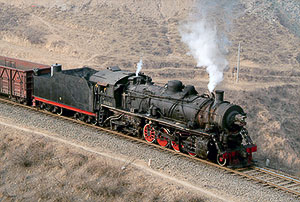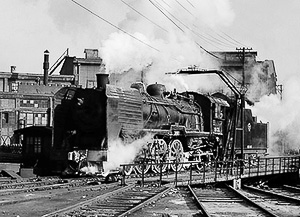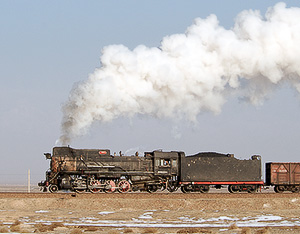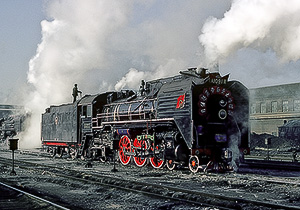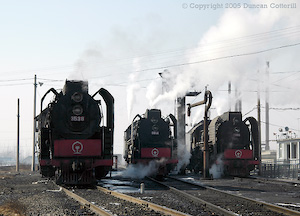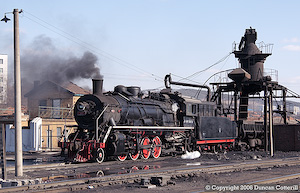A Brief History of Standard Gauge Steam in China
Early Years
The first locomotive to run in China was a tiny 2’6” gauge 0-4-0T built by Ransome & Rapier of Ipswich for the Shanghai – Wusong Railway. The line was opened in 1876 but had not been approved by the local authorities and was soon closed down again.
In 1881 the steam age started for real when British engineer C.W. Kinder cobbled together a locomotive from an industrial boiler and other parts and ran it on the standard gauge tramway he was building to link a mine in Tangshan with a nearby canal. This original route was the basis for what eventually became the Beijing - Tianjin - Tangshan - Shenyang main line.
Construction Boom
The late 19th Century was an era of much foreign involvement in Chinese affairs when the major European powers, America and Russia forced concessions from a declining Qing dynasty government. These included the power to build railways and a construction boom followed. Most of the locomotives for these lines were supplied by the foreign powers’ own builders and followed their own national practices. This situation continued with few changes in most of China until the Liberation in 1949 and resulted in a very diverse fleet of locomotives.
The Japanese Years
At the beginning of the 20th Century Russia was the dominant power in the North-East but Japan also had ambitions in this area and was keen to get access to the mineral resources of Manchuria to fuel its transformation into an industrial power. Japan first fought China for control of Korea in 1895. Although the Japanese won, Russian forces then occupied most of Korea to keep the Japanese out. This led to the Russo – Japanese war of 1904-5. Again Japan won and took over Korea and the former Russian concessions in southern Manchuria as part of the settlement.
The fledgling rail network in the area was quickly transformed into an efficient transportation system designed to reinforce Japanese control and carry huge volumes of Manchurian coal and iron ore to the Korean ports for onward shipment to Japan. Although Japanese railways were 3’6” gauge and most of the Russian built lines in southern Manchuria were the same, standard gauge and American practice were adopted for the South Manchurian Railway and the Japanese built lines in Korea.
Many locomotives were imported from the USA but before long copies were being built in Japanese workshops and eventually in Japanese controlled China itself. Of note was the arrival of the first MiKa-i class heavy 2-8-2 from ALCo in 1918. This design remained in production as the JF until the late 1950s and one was still in traffic as this is written in 2006. The MiKa-i set the standard and a number of similar classes followed, including the JF6 light 2-8-2 that formed the basis of the familiar SY design. For passenger work, very similar light and heavy pacifics were produced becoming SL3 and SL6 classes respectively in the 1951 classification scheme.
As Japan pushed Russia out of northern Manchuria then occupied more of China through the 1930s and 1940s more locomotives were required to operate an expanding rail network and the standard designs were built in ever increasing numbers.
After the Liberation
When the communist government finally took control in 1949 it found the railways in a mess after years of war and occupation. There were a huge variety of different loco types from the former foreign powers, usually in small classes that had little in common. There was also a large fleet of standardised and very capable engines left by the Japanese. It was only natural that the latter were selected for continued production. The first post Liberation JF emerged in 1950 and production of the SL6 design resumed in 1956. The YJ and SY designs were also closely based on the pre war Japanese PL2 class 2-6-2s and JF6 class 2-8-2s respectively.
At the end of WWII China received a number of American locos as reconstruction aid. These included 2-8-0s (sometimes referred to as S160 class) and 0-6-0Ts (sometimes referred to as S100 class) that were a common sight in many parts of Europe. More significant were the 160 UNRRA 2-8-0s that became class KD7. These were thoroughly modern engines and a number of their features were incorporated into new construction.
Russian Assistance
The mid to late 1950s saw the Russians offering technical assistance to their Chinese comrades resulting in the JS class 2-8-2 and RM class 4-6-2 designs. These combined the rolling chassis of the JF and SL6 respectively with Russian design boilers. Another product of this period was the QJ class 2-10-2 that dominated the final years of main line steam operation. These were essentially an enlargement of the Russian LV design and may have been based on a Russian prototype, known as the OR-21, which never went into series production.
Further Russian assistance arrived in the form of 1054 FD class 2-10-2s imported in 1958 and regauged. Poland, East Germany and Russia also supplied tank locomotives to Chinese industry in the same period.
Still Building Steam
China made a conscious decision to continue with steam production long after the rest of the world’s locomotive builders had switched to diesel and electric traction. The reason was entirely practical. Traffic was increasing so rapidly that it wouldn’t have been possible to build diesels fast enough given the skills available in the Chinese workforce at the time. Steam locomotives were relatively low-tech and simple, they could be built in large quantities and ran on cheap and readily available coal.
By the late 1980s China had a dependable home-produced diesel design, the ubiquitous DF4, and a workforce with the skills to build them in quantity. Main line steam production finished at the end of 1988 when the last QJ and JS class locos emerged from Datong works. SY production lasted considerably longer and finally came to an end in 1999.
Main Line Decline
The rapid expansion of China’s rail system from the 1950s led to motive power shortages that kept many old engines in traffic long after they might normally have been retired. The first groups of western enthusiasts to visit in the late 1970s and early 1980s found a large number of pre war locomotives still in traffic or recently retired. Most of the older or non-standard classes had disappeared by the mid 1980s, leaving a very standardised main line fleet comprising mainly QJ class 2-10-2s and JS class 2-8-2s.
The last report of an FD in traffic was in 1985 and the last KD7 was stopped in 1988. The RM pacifics finished in 1990, outlasted by their SL6 predecessors, which continued into 1991. From the late 1980s diesel production was in full swing and even the standard QJ and JS classes were being retired in ever increasing numbers. Against the odds, a few JF soldiered on in CNR service until the mid 1990s leaving only QJ and JS classes in service until the final end in summer 2003.
Industrial Developments
Steam traction lasted longer on industrial and local railways. Until steam had been eliminated from the national system, diesel production was concentrated on large main line units, most of which were unsuitable or too expensive for industrial use. Once again most of the really exotic engines had disappeared before China became a popular destination for enthusiasts but as late as the mid 1990s it was still possible to see a dozen different classes in everyday use. Many industrial users were reluctant to dieselise as steam met their requirements and was cheaper to operate than new diesels.
That all changed in the early years of the 21st Century when CNR began imposing restrictions on steam locomotives operating over their system. Some areas have been more anti-steam than others but many users have been forced to dieselise because they can’t send their steam locos to works over the national system and in some cases the steam locos are even prevented from entering the CNR exchange yards. More recently, the lack of availability of spare parts and concerns about air pollution have been factors pushed industries to dieselise, often reluctantly.
The Current Situation
At the time this was first written in mid 2006 there were still a large number of SY class 2-8-2s in regular use, along with a smaller but still significant number of JS class, but numbers were declining rapidly for the reasons stated above. A few QJs remained on a handful of larger mining systems but the number of active engines was now quite small. The last big user of the class, the JiTong railway in Inner Mongolia was fully dieselised in late 2005. A single GJ class tank and a single JF were still in traffic at the time.
By mid-2012 the volume of steam working had reduced dramatically but there were still a few pockets hanging on. Many industrial railways had closed, gone over to road transport or dieselised, leaving only three significant operations with 10 or more engines and quite a lot more with just a few locos. The last GJ and JF had long since retired and there was only one QJ left. Not surprisingly, the majority of the survivors were SYs but there were still a few dozen JS in use.
Another eight years on and the remarkable thing is that there is still one industrial location that uses several steam locos every day at the end of 2020. I am, of course, referring to Sandaoling, the opencast coal mine in Xinjiang. Getting to see it is another matter, with China off limits to foreign tourists due to the Covid pandemic, not to mention the security situation in Xinjiang having made visits there difficult for the last couple of years. It's possible that there are other locations that still use steam on a less regular basis but nothing has been reported for over a year. How long Sandaoling will survive is anybody's guess. It's been on the verge of closure for several years but has hung on until now. With a contracting market for coal generally and very productive low cost mines still coming into production it can't last for ever.
